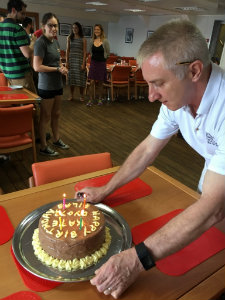We have been at sea for nearly a month, as the guests of the crew of the RRS Discovery. This group of 23 seafarers operate under the leadership of Captain Antonio Gatti. In general, it has taken me some time to get used to the many nautical terms on the ship, but especially the crew members’ titles and jobs. This is not helped by the fact that there are differences between titles in the UK and USA, and between military and civilian ships. The crew are employees of the research council NERC, and are part of the National Marine Facility at the National Oceanography Centre in Southampton.
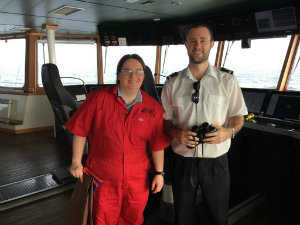 There are essentially two pathways of careers on merchant or scientific ships – the ‘officers’ and the ‘ratings’. Officers can study navigation or engineering, and all need to train for 3 or 4 years to get their ‘ticket’, which allows them to get a job on a ship. The Maritime and Coastguard Agency awards the training certificates. The qualification is taken in phases and includes at least 24 months of classroom training at a nautical college and 12 months at sea. At this stage officers can become Officers of the Watch, of which we have three navigation Officers who man the Bridge (Evelyn, the Chief Officer or First Mate, Colin, the Second, and Tom, the Third). To move up to Chief officer takes another set of training and exams and at least 24 months at sea. Finally, becoming Captain (or Master) requires additional training and experience, including an oral exam and at least another 12 months at sea – and of course being lucky enough to find a job opening on a ship. The Captain runs the ship and has final say on everything.
There are essentially two pathways of careers on merchant or scientific ships – the ‘officers’ and the ‘ratings’. Officers can study navigation or engineering, and all need to train for 3 or 4 years to get their ‘ticket’, which allows them to get a job on a ship. The Maritime and Coastguard Agency awards the training certificates. The qualification is taken in phases and includes at least 24 months of classroom training at a nautical college and 12 months at sea. At this stage officers can become Officers of the Watch, of which we have three navigation Officers who man the Bridge (Evelyn, the Chief Officer or First Mate, Colin, the Second, and Tom, the Third). To move up to Chief officer takes another set of training and exams and at least 24 months at sea. Finally, becoming Captain (or Master) requires additional training and experience, including an oral exam and at least another 12 months at sea – and of course being lucky enough to find a job opening on a ship. The Captain runs the ship and has final say on everything.
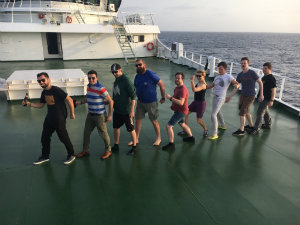
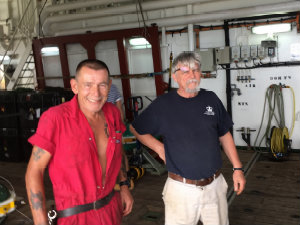
Engineering is another career stream for Officers. The training path is similar to that for the navigation Officers, with a resulting qualification of Engineering Officer of the Watch. There is a cadet in our crew – Taylor – who is midway through his training. Chris is the Second Engineer, but has a budding career in pantomime as Queen Neptune. Angus and Nick are Third Engineers and Tom is the Electronics Officer (pictured at the end of the line in the photo above). These guys seem like they can take apart any part of the ship and put it back together, but are also good to hang around with for spotting wildlife from the front deck. Yesterday, Andy – the chief Engineer – kindly gave us a tour of the ship, showing us the areas that contain the engines, bow thrusters, propellers, drop keel and winches. It is amazing that essentially five people run all of this.
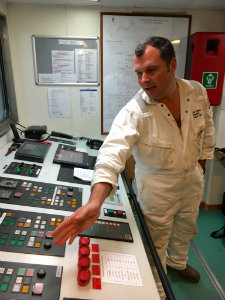
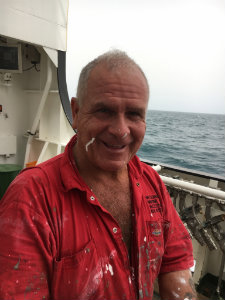
 The ‘ratings’ are men or women who work on deck and have trained as an EDH or efficient deck hand, where they learn everything from winch operation to fire safety. A course and 12 months of sea time is required to obtain an EDH ‘ticket’. The deck crew or Able-Bodied Seaman can be SG1 or SG2, depending on experience – all members of this deck crew are the more experienced SG1. Stuart, the Bosun or Boatswain, is also called the Chief Petty Officer and is in charge of the deck crew. Nathan – the Petty Officer on Deck – is his assistant. The scientific Bosun – Johnny Mac – looks after the scientific crew, which is not easy when a bunch of Pollywogs are running around the deck as instruments are coming on board. He generally runs the winches, whilst cursing at us – but in a friendly way. Andy, Simon, Gary and Chris are ABs who seem to be in a constant state of Brownian motion. They help with the winches, pulling our equipment on board, and running the various instruments off cables. The ship is continuously being painted, which starts with removing rust with a needle gun and disc. A member of this group also works in the engine room – Emlyn is the ERPO (Engine Room Petty Officer).
The ‘ratings’ are men or women who work on deck and have trained as an EDH or efficient deck hand, where they learn everything from winch operation to fire safety. A course and 12 months of sea time is required to obtain an EDH ‘ticket’. The deck crew or Able-Bodied Seaman can be SG1 or SG2, depending on experience – all members of this deck crew are the more experienced SG1. Stuart, the Bosun or Boatswain, is also called the Chief Petty Officer and is in charge of the deck crew. Nathan – the Petty Officer on Deck – is his assistant. The scientific Bosun – Johnny Mac – looks after the scientific crew, which is not easy when a bunch of Pollywogs are running around the deck as instruments are coming on board. He generally runs the winches, whilst cursing at us – but in a friendly way. Andy, Simon, Gary and Chris are ABs who seem to be in a constant state of Brownian motion. They help with the winches, pulling our equipment on board, and running the various instruments off cables. The ship is continuously being painted, which starts with removing rust with a needle gun and disc. A member of this group also works in the engine room – Emlyn is the ERPO (Engine Room Petty Officer).
The Purser – Graham or King Neptune – is the Officer who looks after the accounts, makes sure that we have enough food and supplies, runs the bond (where we can buy t-shirts, sweets, etc.), deals with the port agents, and is head of the stewards and catering team. We have two cooks, Peter and Wally – who are both formally trained in maritime cooking. The food has been really good, especially the soups and desserts. Early in the trip they kindly made Kate a cake for her birthday. Kevin and Tina are the two stewards who keeps things clean and in order on the ship and have basic training in food hygiene and maritime Personal Safety Training. There is never a rest day for this group whilst at sea, as we need to eat.
I have been struck by not only how professional everyone is, but how friendly and welcoming the crew has been. They knew our first names well before we knew theirs. Academics can be real prima-donnas, but the crew take it all in stride. Everyone enjoys their job and there seems to be little friction – below is a picture of them on break or a ‘smoko’ as it is known as sea. The atmosphere is a lot less stressful than that in many conventional offices on land. The maritime profession is dominated by men, but the NMF employs more women than most, including a female Captain, Chief Officer, and 2nd engineer.
